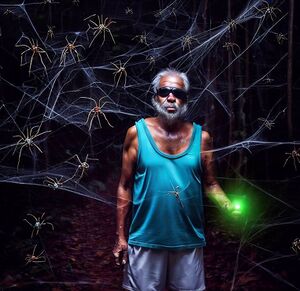Lens of Adaptation: Non-Aversion
 | |
| Lens: Non-Aversion | |
|---|---|
| Beacons | Adaptation |
| Landmarks | Learn About Non-Aversion |
Lenses, in the context of the Beacons of Everyday Enlightenment represent more specific concepts and practices through which we can understand the rich meaning of each Beacon. There are Primary Lenses, which are the most commonly understood and most robust meditative concepts, and there are Other Lenses which are a collection of other closely related ideas for that Beacon.
Non-Aversion, as a concept, invites us to avoid repulsion from negative experiences or sensations. It's about accepting and facing uncomfortable situations, feelings, or thoughts without trying to escape from them. Applying Non-Aversion in our lives means developing a greater resilience to adversity and discomfort. The end-goal is to cultivate emotional balance and courage, promoting a healthier and more flexible approach to life's challenges.
Landmarks
The Realms of Everyday Enlightenment each have some noticeable Landmarks which show the likely alignment someone within that Realm has with each of the Beacons and their various Lenses. These Landmarks are things that need to be noticed and explored in the context of those Lenses and Beacons. And then through working on the Trails and Guides these Landmarks will serve as markers toward the next Realm where new Landmarks await.
Landmarks of Enrollment
Landmark: Learn About Non-Aversion
 | |
| Landmark: Learn About Non-Aversion | |
|---|---|
| Beacons | Adaptation |
| Realms | Enrollment |
| Lenses | Non-Aversion |
| Guides | Stressful Moments |
| Trails | Learn About Adaptation |
The Landmark of Learn About Non-Aversion is where you will practice both experiencing and being patient with aversive sensations.
Review these questions to see if you have fully explored this Landmark and are ready to move on.
Landmark Lookouts:
- Feeling the Aversion: Can you observe what it's like to really want something to be over, and how your mental state changes the longer you sit with that?
- Being Patient: Are you able to feel the mental state of being patient while resting with an aversive sensation?
Itchy skin or scalp is something we all experience commonly, and in fact, if you take a moment you can almost always feel some sort of itch on your body.
- While you're engaged in a routine task, like reading on your phone or watching a show, an itch arises on your skin. Hold off on scratching it immediately.
- Observe the itch. Where is it located? How intense would you rate the urge to scratch it?
- Notice how the itch behaves. It may increase in intensity, decrease, or even seem to move around.
- Feel your hand slowly moving up to scratch the itch, but pause just before you do. There's an anticipation building, isn't there?
- Notice that your mental state is changing as the itch is left unscratched.
- Take another moment to observe the itch, now in its full intensity. Recognize that it's just a sensation on your skin.
- Notice what it's like to rest with the sensation and just patiently observe. Notice that Patience in your mind and body.
- At this point you have two paths to take, choose whichever you want.
- The most obvious option is to give in to the urge and scratch that itch. Feel the immediate relief as the sensation subsides.
- The other option is to wait patiently until the itch goes away. It often does, and if it doesn't, you can always scratch it later.
- Reflect on what you just experienced. You noticed an itch, observed it, and controlled when to respond to it.
- Use this skill the next time an itch arises. It's a simple practice of observing and controlling your responses, instead of automatically reacting.
Landmarks of Engagement
Landmarks for this Realm (Engagement) will be added here when those pages are created.
Landmarks of Enrichment
Landmarks for this Realm (Enrichment) will be added here when those pages are created.
Shadows
The Beacons of Everyday Enlightenment provide powerful guidance through the Realms. The Lenses represent different facets of those Beacons, which provide further focus or illumination of that Beacon. On the other hand, Lenses are also accompanied by two types of Shadows which tend to obscure our journey to Enlightenment. The first kind of Shadows are the Looming Shadows, which are the obvious opposite of a given Lens, and should hopefully be easy to avoid and train against once we understand them. The second kind are the Flickering Shadows, which could be confused with the associated Lenses, because they are quite similar to the Lens, while actually being a harmful or negative counterpart. Both types of Shadows should be understood in the context of the Lens and Beacon, and reviewed periodically to ensure our view is not obscured. Within the Lens of Non-Aversion, we accept and face uncomfortable situations, feelings, or thoughts.
- Looming Shadow - Aversion, is the overt habit of rejecting, avoiding, or being repelled by certain experiences, mistaking avoidance for peace.
- Flickering Shadow - Tolerance of Harm, is when the practice of Non-Aversion leads to tolerating harmful situations or behaviors, misunderstanding acceptance for complacency.
Resources
- Dvesha (Aversion) - "... (hate, aversion) is the opposite of raga (lust, desire) ..."
